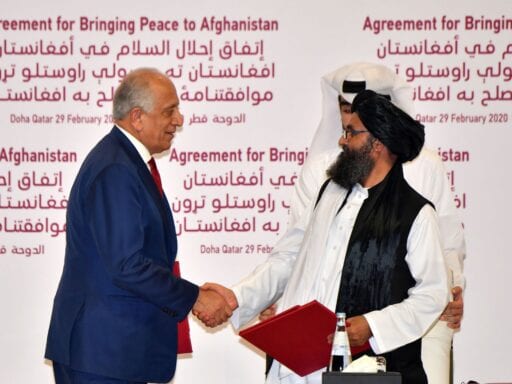Why prisoner swaps are hindering an intra-Afghan peace deal.
President Donald Trump’s vaunted Afghanistan peace deal has already hit a major roadblock, increasing the chance it could fall apart and kickstart a new round of violence.
The US signed two agreements over the weekend: one just with the Taliban, the hardline Islamist group that formerly ran the country and which the US has been fighting against since 2001; and the other a declaration with the Afghan government.
Under the US-Taliban agreement, the US will gradually withdraw its 12,000 service members in exchange for a Taliban commitment to neither aid nor harbor terrorists, as well as to exchange prisoners, and to enter into talks with the US-backed Afghan government. Taliban members will also receive sanctions relief as part of the deal.
But, critically, the agreement also stipulates that Afghanistan’s government and the Taliban must both release political prisoners before talks between the two sides can start on March 10 in Norway.
Those discussions were always going to be very tricky, because the insurgents reject Afghan President Ashraf Ghani’s administration as an American puppet with little control outside the capital.
The discussions are being made even harder by the prisoner swap requirement, which says the government must release up to 5,000 Taliban fighters and the Taliban must free up to 1,000 Afghan security forces. The militant group has long pushed for this, mainly because it would help build up its ranks, but Kabul fiercely rejects the idea.
“Freeing Taliban prisoners is not [under] the authority of America but the authority of the Afghan government,” Ghani told reporters on Sunday. “There has been no commitment for the release of 5,000 prisoners,” he said, adding that the issue could be discussed during peace talks but not as a precondition for them.
Echoing Ghani’s sentiment, a senior Afghan official told me on Monday that this impasse could stall the start of intra-Afghan discussions, noting they won’t start as scheduled if the Taliban insists on a prisoner release first. “It’s our biggest leverage against the Taliban,” the official said. “We are not going to release them without serious progress in the peace process.”
This problem is something the Trump administration should’ve anticipated, or at least done more to manage beforehand. Experts note that the Taliban has long asked for a large prisoner release ahead of talks. That the US made it a precondition before the Afghan government and the Taliban can sit down was always going to rankle the government in Kabul.
The situation has the “potential to bloom into a real obstacle before intra-Afghan talks even get off the ground,” Andrew Watkins, an Afghanistan expert at the International Crisis Group, told me. “A lot depends on how each of the three parties react and engage in the coming days, but that will remain true throughout this process — which, even if it eventually proves successful, will hit plenty more hurdles throughout.”
Expect the resumption of violence in Afghanistan
Peace talks may yet hit another stumbling block: the brisk return of violence.
The US said it would only sign the peace deal after a successful seven-day reduction in violence. That ended last week more or less successfully, leading Washington to greenlight the signing ceremony in Doha, Qatar.
But now that the week-long period is over, the Taliban announced on Monday it will restart operations. It looks like they’ve already begun: A blast in the eastern part of the country killed three people and injured 11 more. “A motorcycle rigged with a bomb exploded during a [soccer] match,” Sayed Ahmad Babazai, a police chief in the area, told reporters.
Sadly, this was somewhat expected. The peace deal didn’t say anything about violence stopping indefinitely after the seven days, just that there had to be a reduction during that week. The Taliban hasn’t technically broken any agreement, experts say, but it will certainly make it harder for the militants and the Afghan government to speak amicably at the negotiation table. After all, the Taliban didn’t have to start killing people again — it definitely had the choice not to do that.
What’s worse, it’s likely the Taliban will continue to attack Afghan forces and innocent civilians for the time being. The group may think doing so heaps pressure on Afghanistan’s government and makes it more likely the government will be willing to make a deal that’s favorable to the Taliban just to get the violence to stop.
Taliban leaders also use violent operations to help keep the organization’s disparate factions somewhat united. “A lot of their collective identity is grounded in their narrative of victory over foreign troops and their so-called puppet partner, the Afghan government,” Watkins, with the International Crisis Group, said.
“In order to keep their group coherent and unified, the Taliban will likely continue to cling to aspects of that narrative — and perhaps even demonstrations of their battlefield capability — even if the peace process continues,” he added.
That has massive implications for the roughly 12,000 US troops in Afghanistan. The Trump administration pushed for a deal to end America’s longest war and eventually bring all service members home within 14 months. But if fighting continues, and there’s no intra-Afghan agreement in the works, then US involvement in the war may not be coming to an end any time soon.
That’s something even Defense Secretary Mark Esper hinted at in his Saturday Washington Post op-ed.
“If progress stalls, then our drawdown likely will be suspended,” he wrote. He continued:
Should the Taliban renege on its obligations, it will bear full responsibility for forfeiting a chance for peace, economic opportunity and a role in deciding the future of the country. Given this possibility, we will retain the necessary capabilities to respond with decisive military force to protect our service members, support the Afghan security forces or restart offensive operations.
In other words, Afghanistan is still a long, long way from peace.
Author: Alex Ward
Read More



